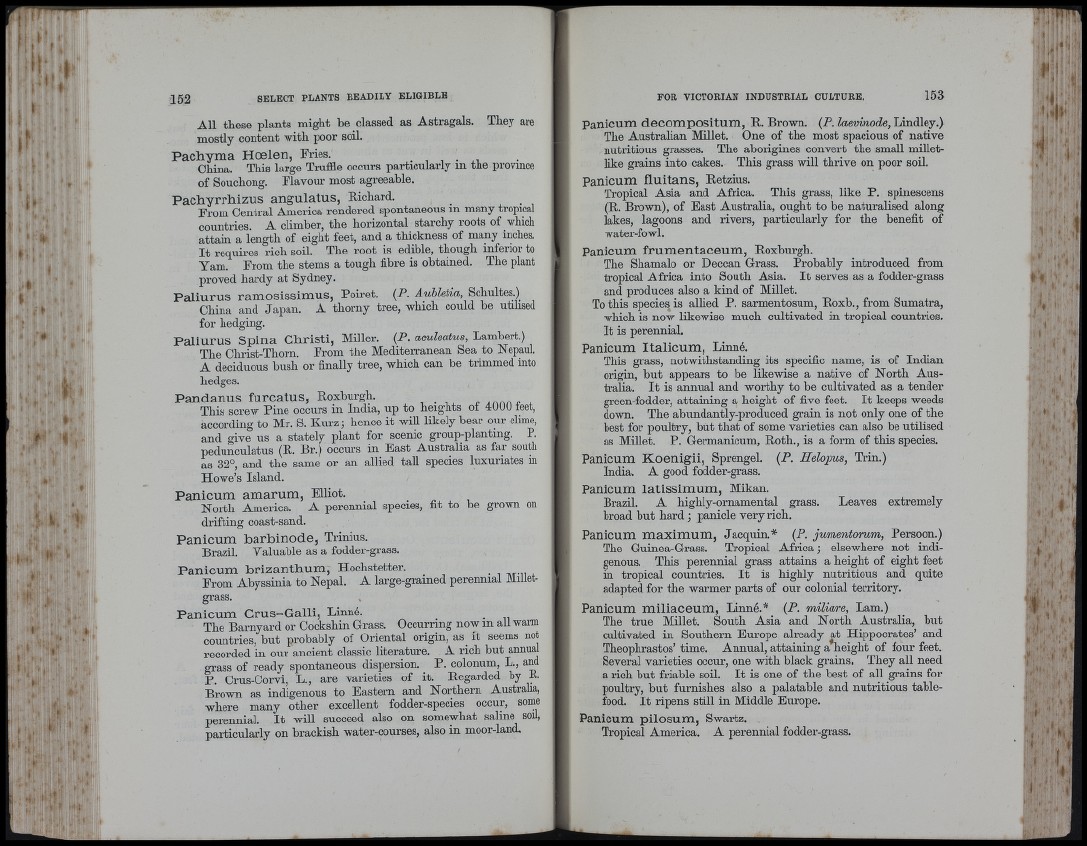
y
t
! H ,4' ■ 4-'
'■ K U 'I:'
r
.. «
'ivr
■" .rti-.iiî
■. f •i 11'
■'
:,i}t
i
. ' 'H qi ■
'
f'ft'i' ., ji^
152 SELECT PLANTS READILY ELIGIBLE
All these plants might he classed as Astragals. They are
mostly content with poor soil.
Pachyma Hoelen, Fries. • i , • .t,
China. This large Truffle occurs particularly m the province
of Souchong. Flavour most agreeable.
Pachyrrliizus angulatus, Richard.
From Central America rendered spontaneous in many tropical
countries. A climber, the horizontal starchy roots of which
attain a length of eight feet, and a thickness of many inches.
I t requires rich soil. The root is edible, though inferior to
Yam. From the stems a tough fibre is obtained. The plant
proved bardy at Sydney.
P a l i u r u s r am o s is s im u s , Poiret. (P. Auhletia, Schultes.)
China and Japan. A thorny tree, which could be utihsed
for hedging.
Paliurus Spina Christi, Miller. (P. aculeatus, Lambert.)
The Christ-Thorn. From the Mediterranean Sea to Nepaul.
A deciduous bush or finally tree, which can be trimmed into
hedges.
Pandanus furcatus, Roxburgh. . . , ^ . .o n n i i
This screw Pine occurs in India, np to heights ot 4ÜÜÜ ieet,
according to Mr. S. Kurz ; hence it will likely bear our clime,
and give ns a stately plant for scenic group-planting. P,
pedunculatus {R. Br.) occurs in East Australia as far south
as 32°, and the same or an allied tall species luxuriates in
Howe’s Island.
Panicum amarum, Elliot.
North America. A perennial species, fit to be grown on
drifting coast-sand.
Panicum barbinode, Trinius.
Brazil. Valuable as a fodder-grass.
Panicum brizanthum, Hochstetter.
Erom Abyssinia to Nepal. A large-grained perennial Milletgrass.
Panicum Crus-Galli, Linné.
Tbe Barnyard or Cocksbin Grass. Occurring now m all warn
countries, but probably of Oriental origin, as_ it seems not
recorded in our ancient classic literature. A rich but annual
grass of ready spontaneous dispersion. P. colonum, L., and
P. Crus-Corvi, L., are varieties of it. Eegarded by K
Brown as indigenous to Eastern and Northern Austraha,
where many other excellent fodder-species occur, some
perennial. I t will succeed also on somewhat saline soil,
particularly on brackish water-courses, also in moor-lanffl
«
FOR VICTORIAN INDUSTRIAL CULTURE. 153
P an icum d e c om p o s i tu m , R. Brown. (P. laevinode, Lindley.)
The Australian Millet. One of the most spacious of native
nutritions grasses. The aborigines convert the small milletlike
grains into cakes. This grass will thrive on poor soil.
P an icum f lu ita n s , Retzius.
Tropical Asia and Africa. This grass, like P. spinescens
(R. Brown), of East Australia, ought to be naturalised along
lakes, lagoons and rivers, particularly for the benefit of
water-fowl.
P an icum f r u m e n t a c e u m , Roxburgh.
The Shamalo or Deccan Grass. Probably introduced from
tropical Africa into South Asia. I t serves as a fodder-grass
and produces also a kind of Millet.
To this species is allied P. sarmentosum, Roxb., from Sumatra,
which is now likewise much cultivated in tropical countries.
I t is perennial.
Panicum Italicum, Lmné.
This grass, notwithstanding its specific name, is of Indian
origin, but appears to be likewise a native of North Australia.
I t is annual and worthy to be cultivated as a tender
green-fodder, attaining a height of five feet. I t keeps weeds
down. The abundantly-produced grain is not only one of the
best for poultry, but that of some varieties can also be utilised
as Millet. P. Germanicum, Rotb., is a form of tins species.
Panicum Koenigii, Sprengel. (P. Helopus, Trin.)
India. A good fodder-grass.
Panicum latissimum, Mikan.
Brazil. A highly-ornamental grass. Leaves extremely
broad but hard ; panicle very rich.
Panicum maximum, Jacquin.* (P. jumentorum, Persoon.)
The Guinea-Grass. Tropical Africa; elsewhere not indigenous.
This perennial grass attains a height of eight feet
in tropical countries. I t is highly nutritious and quite
adapted for the warmer parts of our colonial teimitory.
Panicum miliaceum, Linné.* (P. miliare, Lam.)
The true Millet. South Asia and North Australia, but
cultivated in Southern Europe already at Hippocrates’ and
Theophrastos’ time. Annual, attaining a height of four feet.
Several varieties occur, one with black grains. They all need
a rich hut friable soil. I t is one of tbe best of all grains for
poultry, but furnishes also a palatable and nutritious table-
food. I t ripens still in Middle Europe.
Panicum pilosum, Swartz.
Tropical America. A perennial fodder-grass.
; ’ 'H , .
G i l '
l<w> i I
A
, I»» !
1-7.J 4'i ■
i ;
'■ ■■'■ra.ri,
.11-
"'V ■
"Vi
J
|4 :
f I' -
•J'
I s